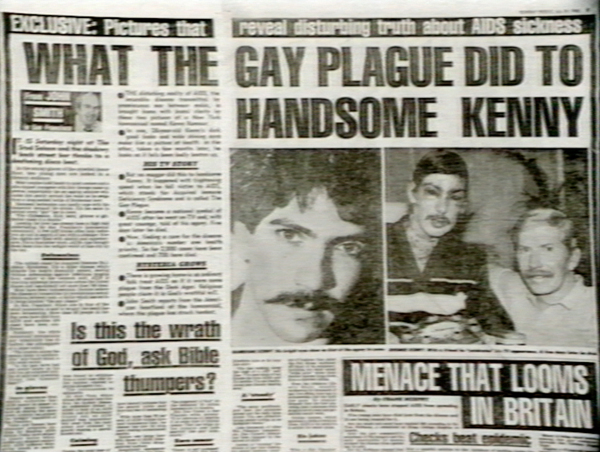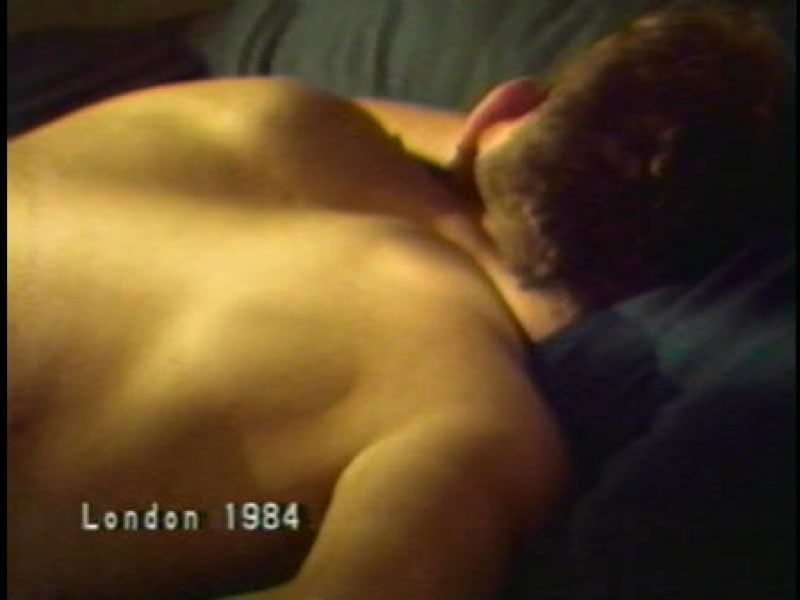Bright Eyes, 1984, video, 80mins (a Caught in the Act Production for Channel Four Television)
“Bright Eyes takes up the topic of AIDS but differs from previous coverage by examining the disease’s social and historical context. … Taking a newspaper article from the summer of 1983 as its starting point, Bright Eyes examines the way in which homosexuality has been described as a disease since the late-nineteenth century. … The final part of the programme uses interviews and drama to describe the anti-homosexual reporting of AIDS by the media and other contemporary threats to the gay community.” (LUXonline)
Comrades in Arms, 1990, video, 48mins (produced by Maya Vision)
“The Second World War is re-examined through the eyes of a group of gay servicemen and servicewomen, whose experiences range from ENSA-style entertainment to the River Kwai prison camp. Personal reminiscences, archive material and stage recreations of gay romances shot in the style of a 1940s back and white movie are combined in an humorous reclamation of a hitherto unrecorded history.” (Rebecca Dobbs, A Directory of British Film and Video Artists, ACE 1994)
This will offer a meditation on the TV video essay, with a particular focus on Stuart Marshall and his documentaries made for television broadcast on Channel Four. The event takes the opportunity to look at works that offer a critique of television and media practice, methods and the way TV represents sexuality and illness, queer histories and public activism. In identifying Marshall’s idea of a ‘committed television’ the symposium will explore issues of experimental TV, the public sphere and public service television, and the artist film on television.
10:00: Registration
10:30am – 12:30pm: Part One: Channel Four, Public Activism and the Public Sphere in the 1980s
Over Our Dead Bodies (Stuart Marshall, 1991, video, 50mins.)
Broadcast as part of the OUT series on Channel Four, 7 August 1991. Produced by Rebecca Dobbs, Maya Vision.
“This film documents the origins of the AIDS activist movement in the US and the UK and the day community’s growing anger and frustration with the totally inadequate response of the US political and medical establishment to the epidemic. While the film celebrates the real successes of this movement, it also examines the problematic debates within it concerning democracy, representation, power differentials, and the relationship between homophobia, racism and sexism. Finally the film describes the birth of groups such as Queer Nation in the US and Outrage in the UK, which have spring out of a newly politicized sense of pride and community fuelled by the AIDS activist movement.” (LUXonline)
Rebecca Dobbs (Maya Vision) will introduce the screening, followed by her presentation, with a response from Daniel Monk (Reader in Law, Birkbeck). This session will be chaired by Janet McCabe (Lecturer in Film and TV Studies, Birkbeck)
12:30pm – 1:30pm: Lunch
1:30pm – 3:30pm: Part 2: The TV essay, television art and the artist film.
In 1991, Stuart Marshall compared working on a television commission to setting up his early sound and video installations, as, ‘a terrific tension – to know that one’s learning in this fantastically public medium’ (Queer Looks; 56). This session will compare continuities and discontinuities in Marshall’s early practice in sound, installation and video with that of his later television documentary and AIDS activism. It will look at how these forms configure audiences and publics and what place models of production, reproduction and distribution have in engaging forgotten vanguard futures, taking into account the differing ethical and political potentials of the distribution collection and the archive, more social forms (such as the reading group, the video workshop and the support group) or ephemeral forms (the script, the manifesto, the petition or the political protest). What role does contemporary art practice play in exploring the horizons of Marshall’s practice, past, present and future and given his commitment to a ‘signifying and oppositional’ practice, what is material for Marshall?
The Love Show, Part One (Stuart Marshall, 1980, video, 23mins.)
With an introduction by Charlotte Procter, Collection Manager at LUX, on materiality, preserving video and the Stuart Marshall collection.
“A narrator describes the beginning of a television programme. It sounds like a ‘made for TV’ movie. He then describes a series of seemingly disconnected scenes, which are illustrated by clichéd sounds effects. A memory test follows. A number of characters—writer, designer, make-up artist who are all played by the same actor—describe their part in the television production process. They seem to have trouble keeping their minds on the matter and their monologues slide away from a description (… the love of their craft to ideological statements about the representation of sexuality in Realist drama production).” (Video Artists on Tour catalogue, 1980, Arts Council)
Discussants include Conal McStravick (artist) and Colin Perry (Central Saint Martins) and chaired by Helena Vilalta (Central Saint Martins).
The Love Show, Part Two (Stuart Marshall, 1980, video, 11mins.)
“The narrative of part one taken up and reworked. The gaps within and the limits of heterosexual representations of sexuality. The articulation of sexuality by the mode of the narration.” (Video Artists on Tourcatalogue, 1980, Arts Council)
4:00pm – 5:00pm: Part 3: Legacy, Preservation, Institutions
The Love Show, Part Three (Stuart Marshall, 1980, video, 12mins.)
“An illustrated news report of a rape. A simulation of ‘committed television’ which produces analysis rather than reportage. Text by Suzanne Brogger. What if the news were to be read differently? Would ‘committed television’ produce an analysis rather than a ‘reportage’? What kinds of images would it use?” (Video Artists on Tour catalogue, 1980, Arts Council)
Followed by a concluding roundtable chaired by Prof. Laura Mulvey (Birkbeck).
Discussants include: Prof. Catherine Elwes (UAL), Isaac Julien (installation art and filmmaker) and Simon Watney (writer, art historian and AIDS activist)




